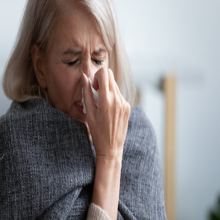With the recent wet weather on the eastern coast of Australia, many people are finding that their homes are affected by mould. But what is mould? Wher...
With the recent wet weather on the eastern coast of Australia, many people are finding that their homes are affected by mould. But what is mould? Where does it come from and what health effects does it pass on to humans?
What is it?
Mould is a type of fungi that occurs naturally in the environment. Mould can be found both outdoors and indoors and it can have a musty-like odour (although more recent research indicates that it is not actually the mould that smells, but the bacteria that it produces). (1)
Mould produces tiny particles call spores, which are carried in the air, helping the mould to grow and spread. These spores can hold toxic chemicals, called biotoxins, that are able to be released into the air.
High amounts of mould can occur in areas of a building that have poor ventilation or become wet and damp. These conditions can increase the amount of mould spores and potentially lead to health problems. People can come into contact with mould spores through inhalation, skin contact or by eating mould affected food. (1)
Where does mould occur?
Mould is very common in buildings and homes. It will grow in places where there is a lot of moisture, such as around leaks in rooves, windows, pipes, or where there has been flooding. It grows on paper products, cardboard, ceiling tiles and wood products. It can also grow in dust, paints, wallpaper, insulation, carpet, fabric and upholstery.
Mould is found both indoors and outdoors. It can enter your home through open doorways, windows, vents and air conditioning systems. It can also grow in the air conditioning system in your car!
Mould from outside can attach itself to clothes, shoes and pets and can be carried inside. When the spores drop in places where there is an excess of moisture, they will grow.
Symptoms of Mould Exposure
Health effects of mould exposure include a runny or blocked nose, irritation of the eyes and skin and sometimes wheezing. For people with asthma, inhaling mould spores may cause an asthma attack. Very rarely, people may develop a severe mould infection, usually in the lungs. It is important to note that most people will not experience any health problems from coming into contact with mould.
People with asthma, allergies, or other breathing conditions may be more sensitive to mould. People with weakened immune systems (such as people with HIV infection, cancer patients taking chemotherapy or people who have received an organ transplant) and with chronic lung diseases (such as Chronic Obstructive Pulmonary Disease (COPD) and emphysema) are more at risk of mould infection particularly in their lungs. (2)
Common symptoms include:
- Irritation in the eyes, nose and respiratory tract
- Cough
- Asthma
- Recurrent sinusitis
- Bronchitis
- Nausea
- Unexplained fatigue
- Fibromyalgia
- Pains and/or numbness in the legs and arms
- Brain fog.
What is CIRS?
Chronic Inflammatory Response Syndrome (CIRS) is a multi-system, multi-symptom illness caused by inhaling biotoxins produced by micro-organisms such as mould and bacteria found in water-damaged buildings. CIRS, when caused by a water-damaged building, is more commonly known as Mould Illness. However, tick-borne infections such as Borrelia (Lyme disease) and Babesia, toxigenic blue-green algae (cyanobacteria), and certain dinoflagellates (associated with ciguatoxin in reef fish) can also produce biotoxins and potentially cause CIRS. (3)
CIRS affects more than just one body system and can have many symptoms. Dr Ritchie Shoemaker has found that 35 of the common symptoms could be classified into 13 clusters. CIRS is now considered when a person has at least 1 symptom from 8 or more clusters (see the image below) for longer than 6 months. A diagnosis is reached after further testing, including genetic testing. We know that approximately 24% of the population carry the gene which predisposes them to CIRS.

What can you do?
You can control mould growth inside your home by:
- Controlling humidity levels.
- If you have an air conditioner, put it on the ‘dry’ function (usually the icon with the water drops).
- Limit the use of humidifiers.
- Limit the number of fish tanks and indoor plants.
- Limit the use of unflued gas heaters.
- Fixing leaky roofs, windows and pipes
- Thoroughly cleaning and drying after flooding; discard material that cannot be cleaned and dried properly.
- Ventilating the bathrooms, laundry and cooking areas. Use exhaust fans that ventilate to outside the home rather than into the roof cavity. Open windows when weather permits to improve cross-ventilation
If you have mould in your home, it is best to remove it as soon as it appears. This may take a bit of elbow grease! Here are some tips on how to do it (2):
- For routine clean up of mouldy surfaces, use mild detergent or vinegar diluted in water solution (4 parts vinegar to 1 part water). Add a few drops of Oil of Clove to kill the spores. Find out more about Oil of Clove for mould here.
- If the mould is not readily removed and the item cannot be discarded, use diluted bleach solution (250mls of bleach in 4 litres of water) to clean the surface. When using bleach, protective equipment is recommended: PVC or nitrate rubber gloves; safety glasses; and safety shoes. Make sure the area is well-ventilated while you are cleaning with bleach.
- Ensure the surface is dried completely once cleaned.
- Absorbent materials, such as carpet may need to be professionally cleaned or replaced if they are contaminated with mould.
Should you get your home tested for mould?
Most mould is visible, so it is generally not necessary to test for mould. However, it could still be present in wall or ceiling cavities. If you think you have mould in your home, but cannot find the source, you could consider contacting a building biologist for further investigation. You can find more information and contacts for building biologists here.
Further Information
If you are concerned that you have mould illness, speak to your healthcare practitioner, or book an appointment with one of the AMC naturopaths or nutritionists.
References
- Parliament of Australia, 2018, Possible Health and Social Impacts of Exposure to Mould, viewed 22 March 2022, https://www.aph.gov.au/Parliamentary_Business/Committees/House/Health_Aged_Care_and_Sport/BiotoxinIllnesses/Report/section?id=committees%2freportrep%2f024194%2f26281
- NSW Health, 2022, Mould, NSW Government, viewed on 23 March 2022, https://www.health.nsw.gov.au/environment/factsheets/Pages/mould.aspx
- Di Lizo S, 2020, Chronic Inflammatory Response Syndrome (CIRS) Explained, Toxic Mould Support Australia, viewed 23 March 2022, https://toxicmould.org/cirs-explained/
About The Author - AMC Team
Our team consists of doctors, nurses, program assistants, naturopaths and nutritionists that join their wealth of knowledge to offer our patients and website visitors interesting and insightful articles to assist you understand the symptoms you are experiencing and how to relieve them.
You’ll also like these posts
 Read more
Read more
 Read more
Read more
With the recent wet weather on the eastern coast of Australia, many people are finding that their homes are affected by mould. But what is mould? Wher...

